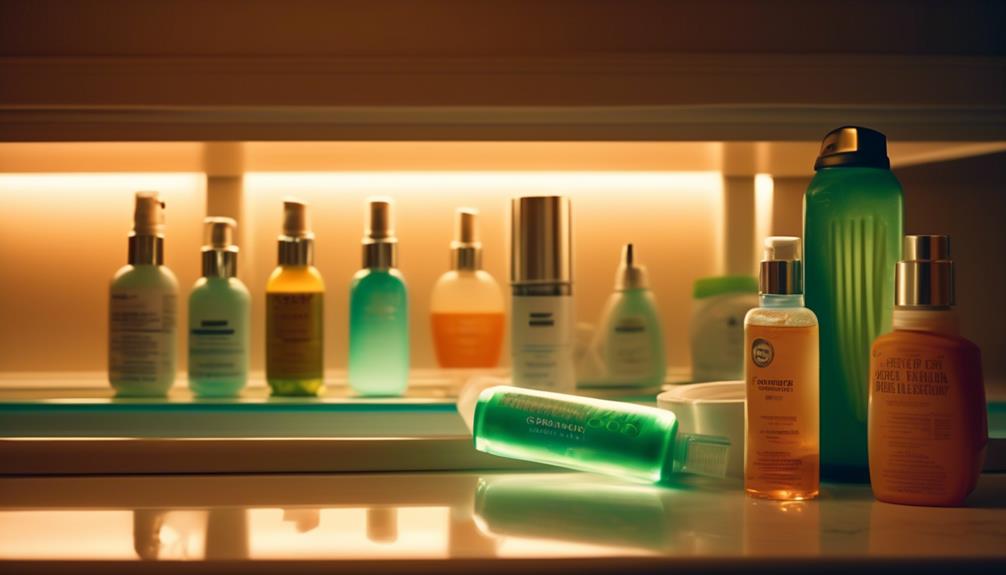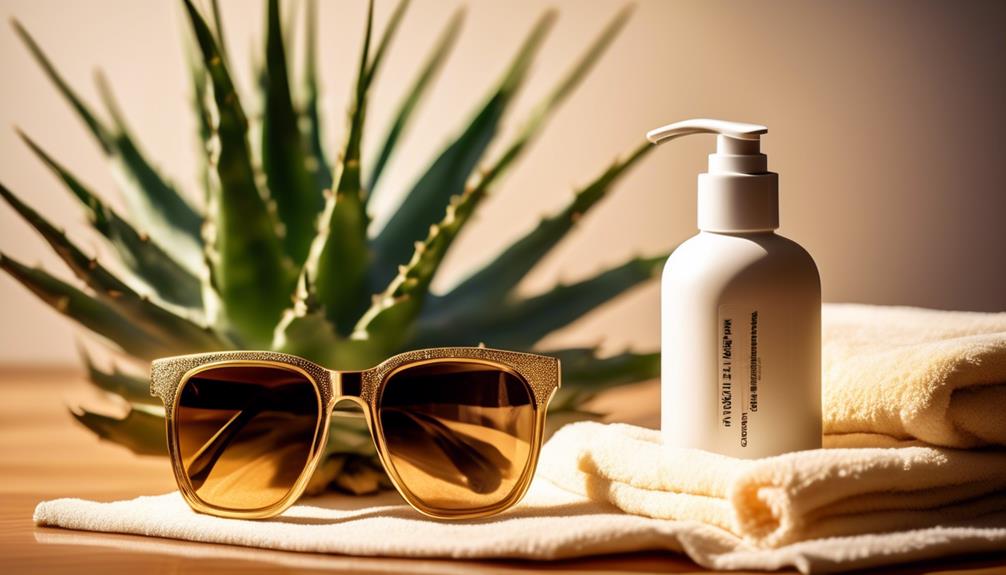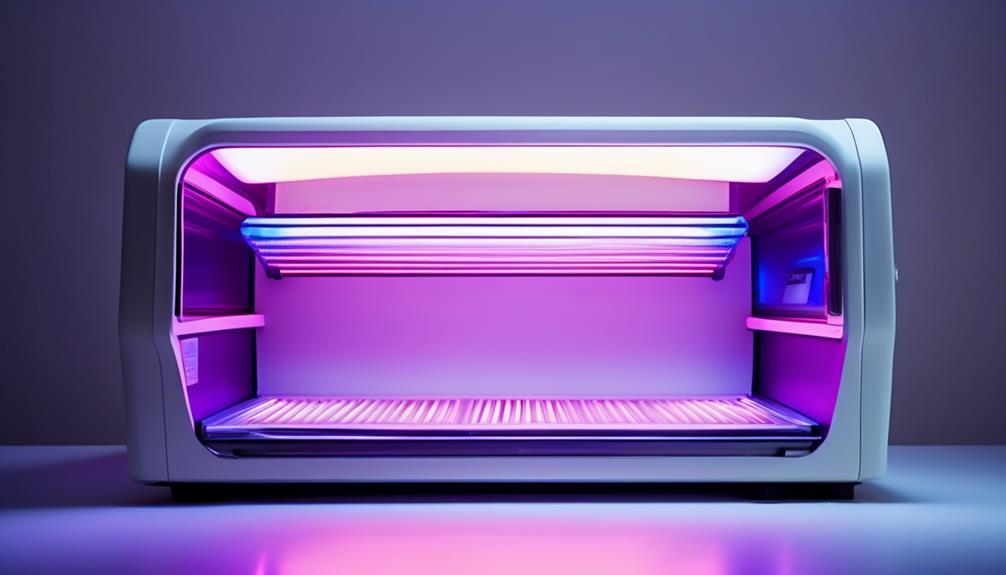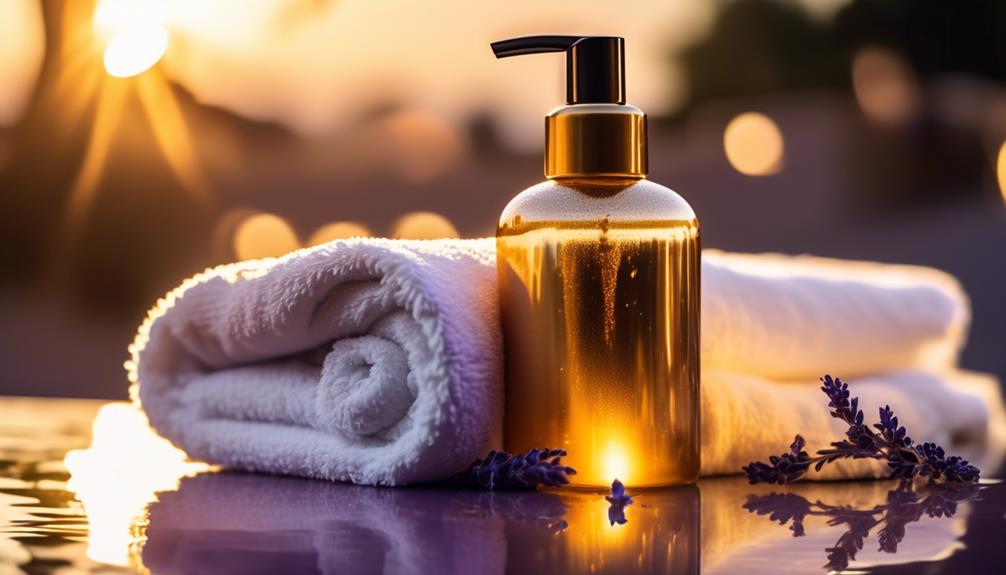Tantalizing tan lines might tempt you to take the tanning bed plunge, but before you bask in that artificial glow, let’s talk turkey about the trade-offs.
You’re savvy enough to know that when something sounds too good to be true, it usually is, and the bronzed skin from tanning beds is no exception. While you’re chasing that sun-kissed look, your skin could be soaking up a whole lot more than just UV rays. We’re talking premature aging, an increased risk of skin cancer, and a host of other health hazards that don’t exactly scream ‘beach bod ready’.
So, let’s get down to the nitty-gritty of how you can keep that glow without compromising your well-being. Stick around, and you’ll uncover some skin-saving tips that might just change your sun-seeking strategy for good.
Key Takeaways
- Tanning beds significantly increase the risk of skin cancer, including melanoma, squamous cell carcinoma, and basal cell carcinoma.
- UV radiation from tanning beds causes premature aging, such as wrinkles, sunspots, and loss of elasticity.
- Early detection of skin cancer is crucial and can be life-saving.
- UV-blocking goggles should be worn to protect the eyes from serious risks like cataracts when using tanning beds.
Assessing Tanning Bed Safety
Let’s get real about tanning beds—they’re not the skin’s BFF you might think they are. We’re talking major faux pas for your glow-up routine. When you’re cozying up in those UV-packed cocoons, you’re seriously upping your risk of skin cancer. It’s like playing roulette with your health—melanoma, squamous cell carcinoma, and basal cell carcinoma are crashing the party, and trust me, they’re not the plus-ones you want.
And let’s not gloss over the addiction factor. Chasing that bronzed look can mess with your head, big time. Anxiety and a distorted self-image? No thanks. We’re after confidence, not consequences.
You’ve heard the stories, right? Take it from skin cancer warriors like Brittany Cicala—this is no joke. Their battles are the reality checks we all need to ditch the beds and embrace safer shine. Think spray tans, self-tanning lotions, or just rocking the natural vibe with sun protection on point.
It’s all about keeping it real with your health. Sun-kissed, not sun-compromised—that’s the mantra. So, let’s get that skin care routine sparkling sans UV radiation, shall we?
Understanding UV Radiation Effects
With UV radiation effects, you’re facing more than just a risk—it’s a full-on assault on your skin’s health, with skin cancer waiting in the wings. Those UV rays you’re soaking up? They’re like frenemies to your skin—giving you that sun-kissed glow while secretly causing havoc. Ultraviolet radiation goes deep, breaking down the fibers in your skin, which can lead to premature aging. Think wrinkles, sunspots, and a loss of elasticity way before your time.
Tanning and skin trouble go hand in hand. That bronzed look might be hot now, but the risks of developing skin cancer, like the dreaded melanoma, skyrocket, especially for you, the younger crew. It’s like playing Russian roulette with your health—each tanning session could be loading another bullet.
Let’s get real about the health risks of tanning beds. They’re not your skin’s BFF. With skin cancer awareness on the rise, survivor stories are painting a not-so-pretty picture of life post-diagnosis. And with the FDA eyeing up the tanning industry for tougher controls, it’s clear that the effects of UV radiation are no joke. So, think twice before you chase that tan—it might just cost you your glow, and then some.
Identifying Skin Cancer Symptoms
If you’re spotting moles doing the shape-shift or your skin’s throwing up some red flags like new spots or persistent sores, it’s time to chat with a skin doc, stat.
And don’t shrug off that itch or ache on your skin – it might be gossiping about something way more serious.
Recognize Suspicious Moles
Spotting a mole with funky edges or a patchwork of colors on your skin? That’s your cue to book a chat with your dermatologist, pronto. It’s all about keeping your skin health on point, and recognizing those suspicious little signs can be a total game-changer. Let’s keep it real—your skin’s telling a story, and those moles could be sneaky signs of aging, or worse, whispers of skin cancer.
- Asymmetry in moles – love your unique quirks, but in moles, symmetry is key!
- Evolving shape or size – if your mole’s changing, it’s not just vibing, it’s alarming.
- Larger than a pencil eraser – size matters, and this could be a big red flag.
- Itchy or bleeding moles – definitely not the kind of attention you want from your skin.
- Multiple colors – your mole shouldn’t be throwing a rainbow party.
Stay vigilant, stay radiant. Remember, catching these clues early can be a total life-saver.
Changes in Skin Texture
If your skin’s texture is going rogue with rough patches or unexpected lumps, it’s time to get that checked out—because these rebels could be signaling skin cancer.
Those tanning beds you love? They come with risks, and not just the kind that can be bronzed away. Health is the new glow-up, and skin cancer is def not on the mood board.
Rough, scaly patches or new lumps? That’s your skin screaming ‘SOS!’ from potential sun damage. Don’t just slap on moisturizer and hope for the best. Keep your skin healthy by staying alert to these skin conditions. Cancer doesn’t care about your tanning schedule, so prioritize that derm visit. Your flawless future self will thank you.
Unusual Growth Monitoring
While rough patches and lumps are red flags for skin damage, keeping an eye out for unusual growths is key to catching skin cancer symptoms early. Tanning beds might seem like your fast track to that sun-kissed look, but the UV light is no joke when it comes to the risk of developing skin cancer.
- Changing moles: If they’re switching up more than your wardrobe, it’s a sign.
- Itchy spots: That nagging itch could be your skin whispering, “Check me out.”
- Bleeding growths: If it weeps, it’s time to leap into action.
- Non-healing sores: Open wounds that won’t quit? Don’t ignore, explore!
- Basal cell carcinoma vibes: Any shiny or waxy bump could be more than just skin deep.
Monitoring your skin is a love language. Listen closely.
Eye Protection and Tanning Beds
Don’t skimp on the specs—rocking those UV-blocking goggles is a must to dodge serious eye risks like cataracts.
You wouldn’t sunbathe without sunscreen, right? So don’t hit the tanning bed without shielding those eyes; it’s non-negotiable.
UV Ray Eye Risk
Rocking that bronzed glow from a tanning bed comes with a serious caveat: skip the eye protection, and you’re flirting with damage like cataracts or even cancer. The World Health Organization warns that using a tanning bed can significantly increase your risk. So, when you’re chasing that sun-kissed look, remember it’s not just about wearing protective clothing for your skin.
- Always slip on those funky UV-protective goggles; your eyes will thank you.
- Ignoring eye safety is a no-go; cataracts aren’t a cute accessory.
- imagine missing out on seeing life’s beautiful moments.
- UV light doesn’t discriminate; it’ll take aim at your peepers.
- Protective clothing? Yes. But don’t forget your eyes are on the frontline too.
Stay safe, stay fabulous, and shield those windows to your soul.
Protective Eyewear Essentials
Donning those UV-blocking goggles is your best bet for keeping your eyes in the clear while you get your tan on. Trust me, when you’re lying in that tanning bed, feeling the warmth, you don’t want to toy with UV light. That’s some serious stuff that can increase your risk of some not-so-chic eye issues.
While we’re talking protection, slather on that sunscreen to guard your skin from those sneaky UVA rays that could lead to skin cancer.
Next time you hit the tanning salon, make sure you’re not just thinking about that bronzed glow. Rock that protective eyewear like it’s the hottest accessory. Your future self will thank you for it.
| Must-Have | Why It’s Hot | What’s Not |
|---|---|---|
| UV Goggles | Safeguard peepers | Skipping ’em |
| Sunscreen | Skin defense | Ignoring risks |
| Knowledge | Power moves | Playing it cool |
Evaluating Tanning Lotion Ingredients
When choosing your glow-up arsenal, it’s crucial to scrutinize the ingredients in tanning lotions, steering clear of anything that might harm or irritate your skin. After all, the goal is Healthy Skin that radiates, not redness and regrets. Remember, tanning beds aren’t just about that immediate bronze; it’s about how you nurture your skin in the process.
Now, let’s get real about evaluating tanning lotion ingredients. You don’t want to slather on something that could backfire, leaving you with more than just a sassy glow. Check out these must-avoids and must-haves:
- Harsh Chemicals: If it’s hard to pronounce, it might be hard on your skin.
- Fragrances: Your skin’s health isn’t a perfume ad; skip the unnecessary irritants.
- Antioxidants: Think of these as your skin’s BFFs, fighting the good fight against UV light damage.
- Moisturizers: Hydration is key – keep your skin quenched while you bake.
- SPF Protection: Because skin cancer is no joke, and tanning can cause some serious oopsies.
Consult with a dermatologist if you’re in doubt. They’ll guide you on what’s a safe alternative and what’s not. Because you’re not just tanning – you’re investing in your skin’s health.
Hygiene Concerns With Shared Equipment
While you’re busy making sure your tanning lotions are skin-friendly, don’t overlook the importance of clean tanning beds to dodge unwanted skin dilemmas.
Nobody wants to lie in a tanning bed that’s not been loved with a good scrub down. When you use tanning beds, you’re sharing equipment that can be a hotspot for ickiness if not cleaned properly.
While using shared tanning bed, you will always have this question in mind, “Did the last person leave more than just good vibes in that tanning booth? “.
Eek!
UV rays might zap some germs, but they’re not a cure-all. A tanning bed rash or, worse, warts? No thanks!
Balancing Tanning With Skincare
You’re playing with fire if you think you can tan relentlessly and still rock flawless skin, because those UV rays don’t just bronze—they can also seriously damage.
Those tanning beds might seem like a fast-track to that sun-kissed look, but UV light is no joke when it comes to your skin’s health. We’re talking increased skin cancer risk, and nobody’s got time for that.
You’ve gotta balance that craving for a healthy glow with a solid skincare routine that protects skin. Think of it as sunburn prevention with benefits.
Don’t worry, you can still snag that vitamin D without going overboard.
- No more ignoring the risks: Tanning addiction is real, and so is skin cancer.
- Get informed: The FDA is eyeing up tanning beds with tighter reins.
- Listen to survivors: Brittany Cicala’s story isn’t just a cautionary tale—it’s a wake-up call.
- Fake it ’til you make it: Safer options like spray tans and lotions give you that glow, guilt-free.
- Love your skin: Take care of it, and it’ll shine—no UV required.
Let’s keep it glowing, but let’s keep it safe too, okay?
Alternatives to Indoor Tanning
Let’s explore some skin-friendly alternatives that’ll keep you looking lit without the sun hit. Instead of baking under harmful UV light, risking skin cancer, and upping your odds to develop skin cancer, why not play it smooth and smart?
Ditch the tanning beds and sun lamps; those bad boys can mean a greater risk of skin cancer.
You’ve still got options to glow up safely. Try an airbrush tan at your fave salon—they’ve got the skills to give you that sun-kissed look without the cancer risk increases. Or, become a DIY bronzing artist with self-tanners; lotions, sprays, gels, drops—you name it.
Here’s a quick cheat sheet:
| Method | Perk |
|---|---|
| Sunscreen | Shields from UV, lowers cancer risk |
| UPF Clothing | Stylish & safe |
| Airbrush Tan | Instant glow, zero UV |
| Self-Tanner | Custom tan, all in your control |
Always wear sunscreen, even with your faux glow. It’s like a love letter to your skin saying, “I’ve got you covered.” Remember, the best tan is a safe tan, and you’re too fab to fry. Stay radiant, stay protected, stay you.
Frequently Asked Questions
What Are the Risks of Tanning Beds?
You’re playing with fire using tanning beds. They’re not just a fast track to that sun-kissed look; they’re a shortcut to skin woes, including a serious uptick in your skin cancer odds. We’re talking melanoma—the real deal.
Plus, don’t get me started on the aging effects; hello, wrinkles! It’s high time to embrace your natural glow or find safer ways to bronze up.
Your skin will thank you later.
Is It Bad to Look at Tanning Bed Lights?
Absolutely, you shouldn’t stare at tanning bed lights! They’re super intense and can harm your eyes. Think about it like staring at the sun – a major no-no.
Always wear protective goggles to shield those peepers. You’re not doing yourself any favors by risking it.
Keep it safe and smart, and you’ll thank yourself later. Protecting your vision is just as crucial as rocking that glow!
What Does Tanning Bed Lights Do to Your Eyes?
You’re risking serious eye damage by exposing them to tanning bed lights without protection. These lights emit UV radiation, which can lead to conditions like cataracts or even cancer.
You mightn’t feel it immediately, but over time, the harm adds up. So, always wear those funky goggles.
Think of them as your eyes’ besties, shielding you from the sneaky dangers while you’re getting that sun-kissed look.
Stay safe, not sorry!
Can You Be Allergic to Tanning Bed Lights?
You might think you’re allergic to tanning bed lights, but it’s not a typical allergy. It’s more likely your skin’s telling you, ‘This is bad!’
Those lights emit UVA rays which can seriously irritate your skin. If you’re getting rashes or itchy after a session, it’s a red flag.
Better to embrace that natural glow or find a fake tan that doesn’t leave your skin screaming for help.




